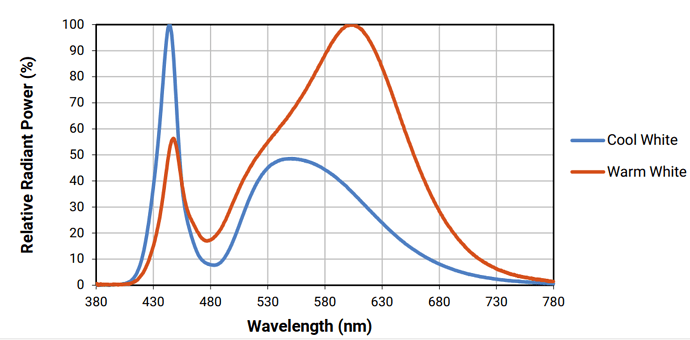well, the old way of watching a movie was to use an enough bright lamp in a projector, watching the sceeen with your own eyes.
Whatever specific type of lamp was used in these old days, the spectrum of the lamp was rather close to a continuous spectrum which would be quite similar to what is called “black body radiation”. Black body radiation describes (simplified) how a hot piece of matter would radiate different wavelengths with different power. The power for a certain “color” (wavelength, to be precise) is basically given by the temperature of the lamp. Short wavelengths (“blue”) radiate substantially less power than longer wavelengths (“red”). The hotter the lamp gets, the blue wavelengths become more prominent, as the power distribution changes toward the shorter wavelengths. The lamp turns from a reddish shine to a more white appearance.
The most important point here is however: the spectrum of a projection lamp is a continuous spectrum, very different from the spectrum you see in LEDs, even in white-light LEDs with a high CRI.
The whole old movie production chain (whether it was the complicated process of 35 mm film stock with intermediates or a simple color-reversal film like Super-8) was optimized for displaying the movie’s content through such a lamp, being viewed with the peculiar sensitivities of the human eye.
Clearly, no LED-based illumination system comes even close to this situation. LEDs have a very narrow spectrum with mostly one, occasionally several, but rather sharply peaked maxima.
If you are sampling film with such narrow LED spectra, you end up sampling your source spectral wise in a very small regime. What the camera sees in that narrow regime might match what the observer in the original cinema situation would have seen, but there is no guaranty.
You might end up with weird color-shifts if the narrow LED spectral line just by chance hits a local minima in the films dye spectrum. With the smooth spectrum of the old projection lamps, that issue was simply of no concern. Whether it is a real issue while scanning is hard to tell. It will certainly depend on the specific film stock/LED-combination you are working with. Bad thing: you would probably not even notice such a misalignment between film dyes and LED spectra since you usually do not have a reference on how the original color sensation would have looked like.
If your scanner is working with something close to the original illumination used (=broad spectral distribution of the lamp) and your camera is close to the human color perception, the chance to sample the colors like they originally appeared in the cinema increases. I tried some time ago to do a little research into that, but because of the unavailability of film dye spectra as well as camera sensitivity data I didn’t get too far. I noticed in experiments some differences in scanned colors when testing LEDs with different wavelengths on the same film stock, but in the end, I just used some LEDs which worked ok with my specific film stocks. It’s probably only a minor issue and might be correctable in post production. But I haven’t looked into that.

